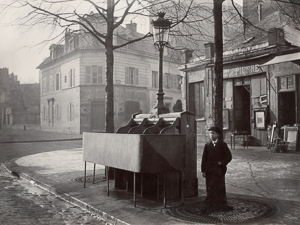Did you know that the first photograph taken with people was in Paris? Louis Daguerre used his new technique called Daguerreotype to take the photo in 1838. It was called “Boulevard du Temple.” Despite the street being extremely busy with pedestrians and a lot of traffic, only two individuals showed up in the photo—someone shining the boots of a man. The exposure time necessary was more than 10 minutes and so those 2 individuals must have stood relatively still for that time to be captured.

Charles Marville (1813–1879) was one of the early photographers in Paris. His photographs of Paris in the mid-1800s are the best representations of the streets and buildings prior to their destruction by Napoléon III and Baron Haussmann. Many of his photos give you a good sense of what medieval Paris might have looked like (i.e., narrow streets, houses, workers such as the tanners, and streets used as the sewer). Many of Paris’s historically significant buildings were demolished over a 22-year period as Napoléon III carried out his vision of modernizing the city.
Marville was born Charles-François Bossu. He changed his name to Charles Marville in 1837 presumably since his last name, Bossu, means hunchback. Right about the same time, Victor Hugo published The Hunchback of Notre Dame in 1837 (was it really a coincidence he changed his name at that particular time?).
Monsieur Marville was named in 1862 as the photographe de la ville or photographer of the city. In this capacity, he began a series of official photographs called Le Vieux Paris (Old Paris) that captured certain parts of the city—buildings and streets—before Haussmann demolished them. This album of work consisted of approximately 450 photographs. They encompass his work over a 7-year period ending in 1869.

It is likely that many of Marville’s early photographs were destroyed. The city of Paris would have owned his photos and since the Hôtel Carnavalet (today, the museum of Paris) was undergoing renovations at the time, the collection of photos would have been held at the Hôtel de Ville (city hall). When the Hôtel de Ville was destroyed by fire during the Commune in May 1871, the photos would have perished (along with much of the written documentation of the French Revolution).
Charles Marville and his collection of old Paris photographs would not be discovered until the 1980s. Today, they are part of the collection held by Roger-Viollet (6, rue de Seine) and loaned out to museums around the world for special exhibitions. This is the photographic agency owned by the city of Paris. It owns, controls, and licenses almost all the official photos of Paris, photos of the relics held by the city owned museums, and other related photographs.
If you enjoy the historical aspect of Paris, don’t miss one of the Charles Marville photography exhibitions that come to your town. I know I won’t.
Do we have a lot of stories? Of course we do. I’m looking forward to sharing these with you. Please continue to visit our newsletter and blog. Perhaps you’d like to subscribe so that you don’t miss out on the most recent newsletter and blog posts.
Thanks so much for following my newsletter and blogs as well as my little journey through this incredibly interesting process of writing a series of niche walking tour books based on European historical periods or events.
– Stew
Please note that I do not and will not take compensation from individuals or companies I mention or promote in my blog.
Are you following us on Facebook and Twitter?
Copyright © 2015 Stew Ross

